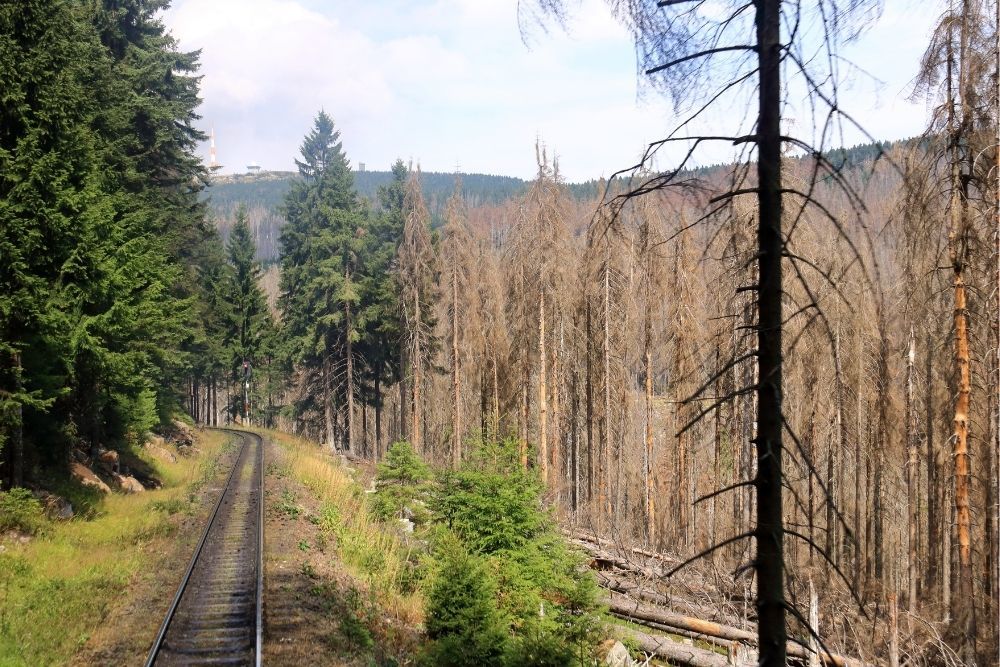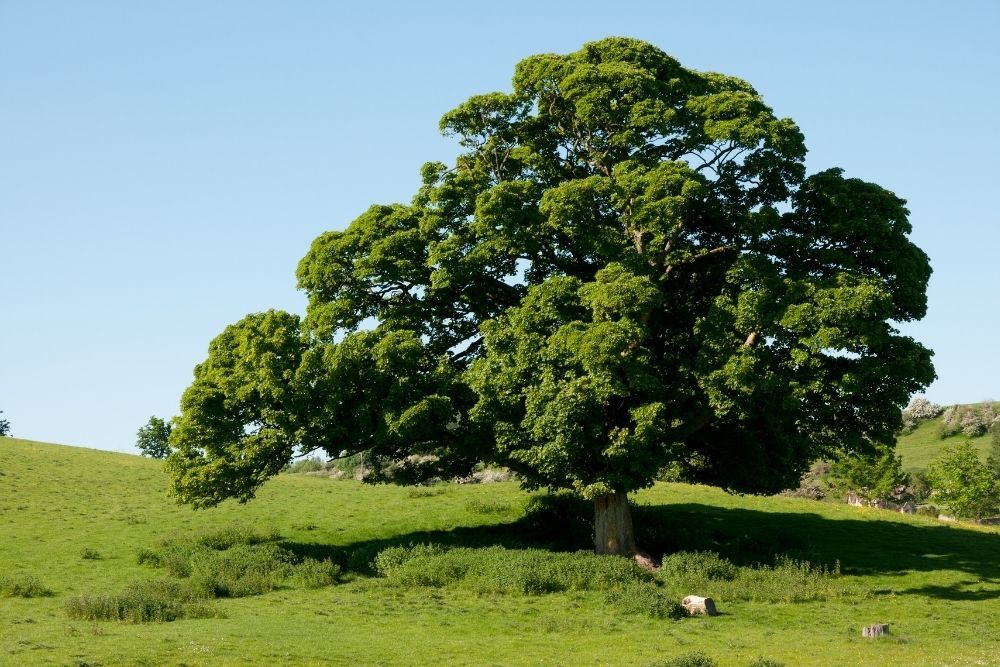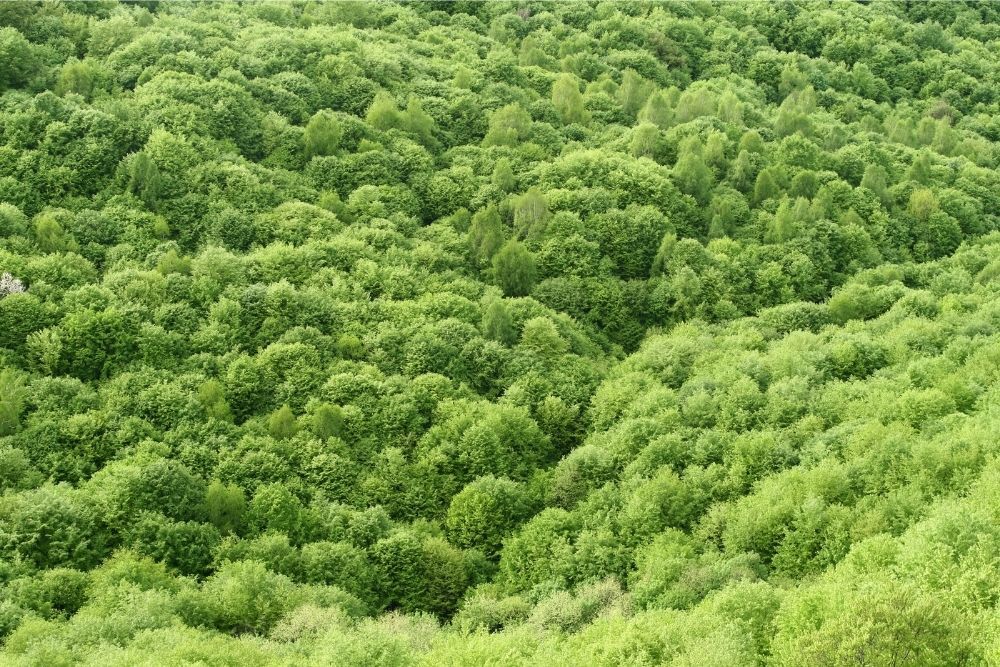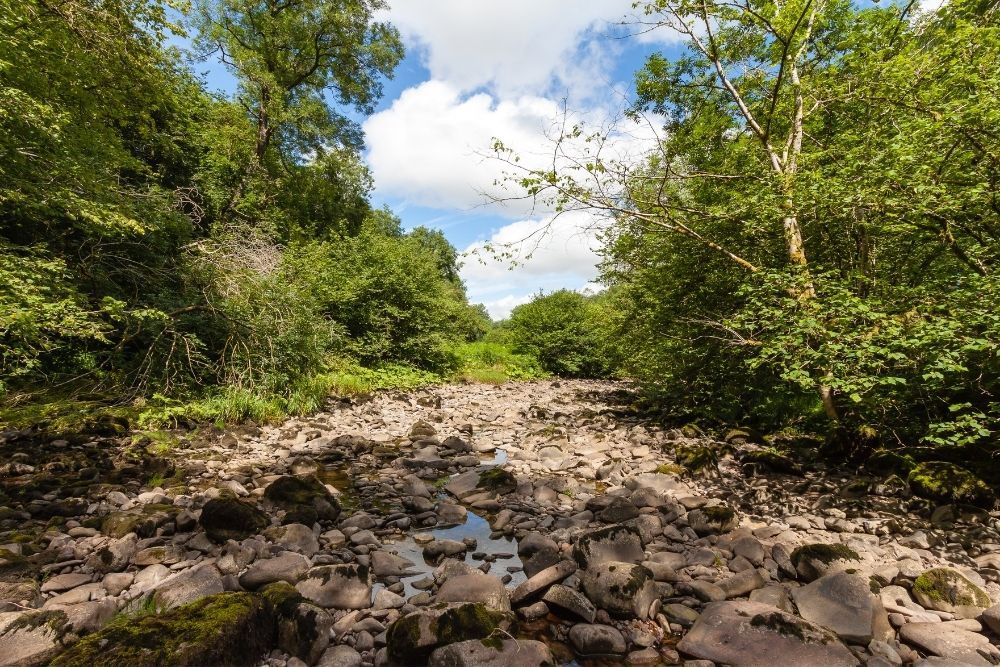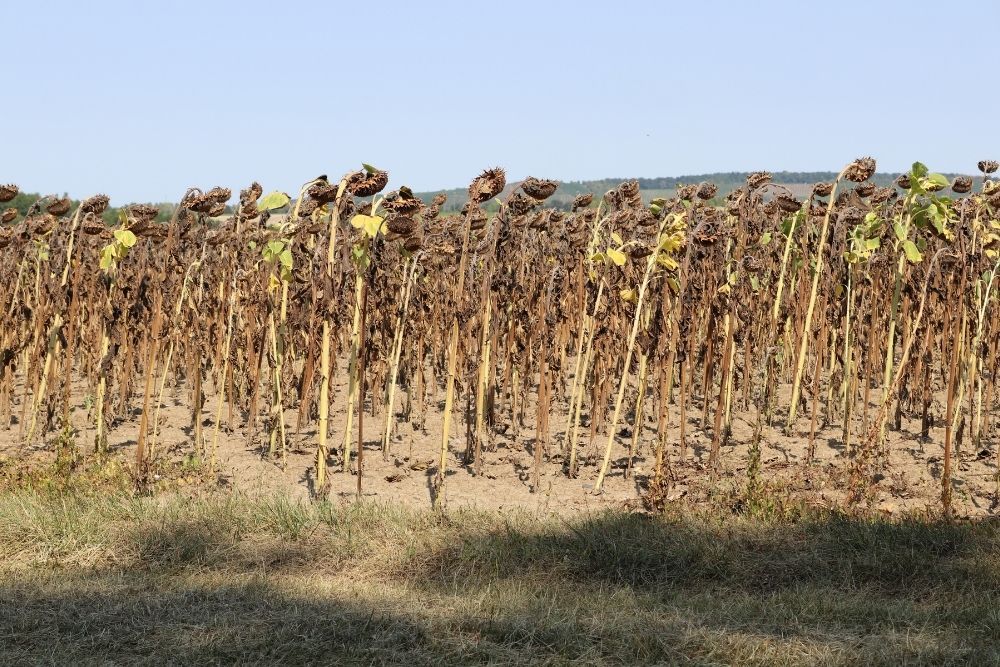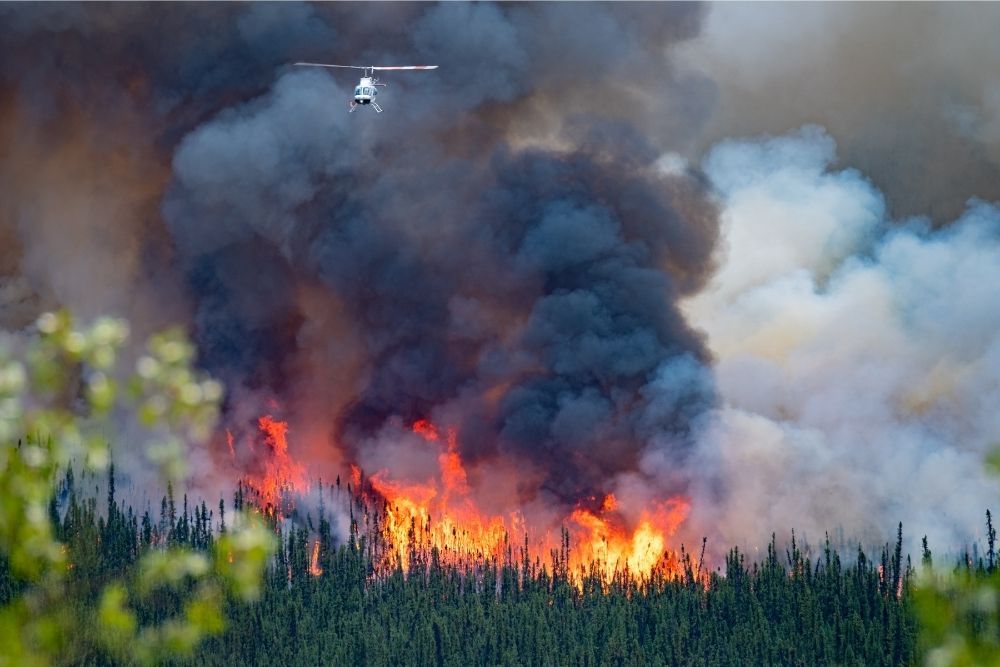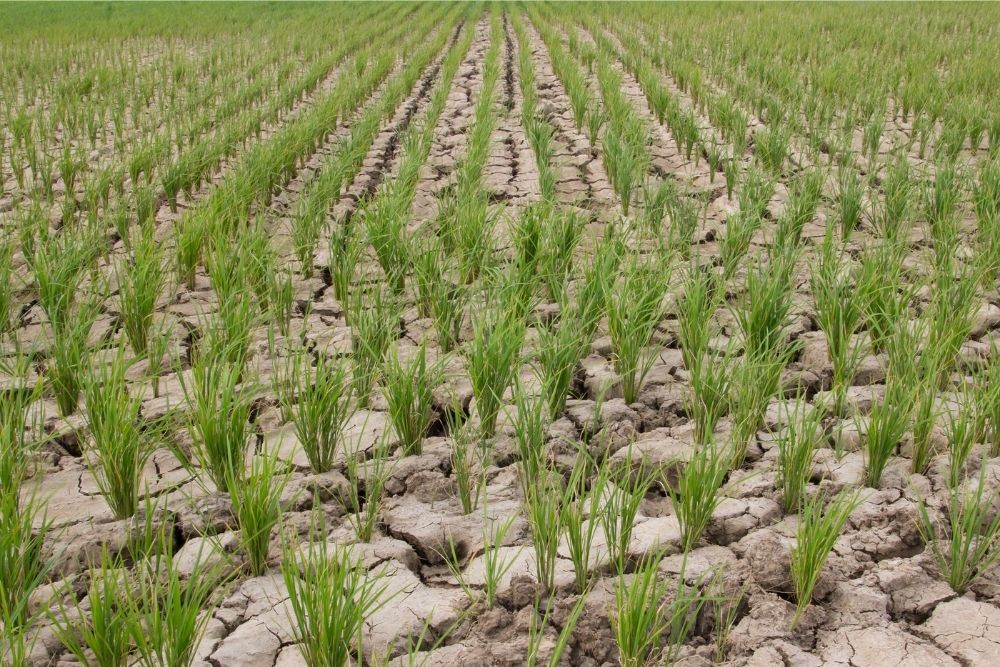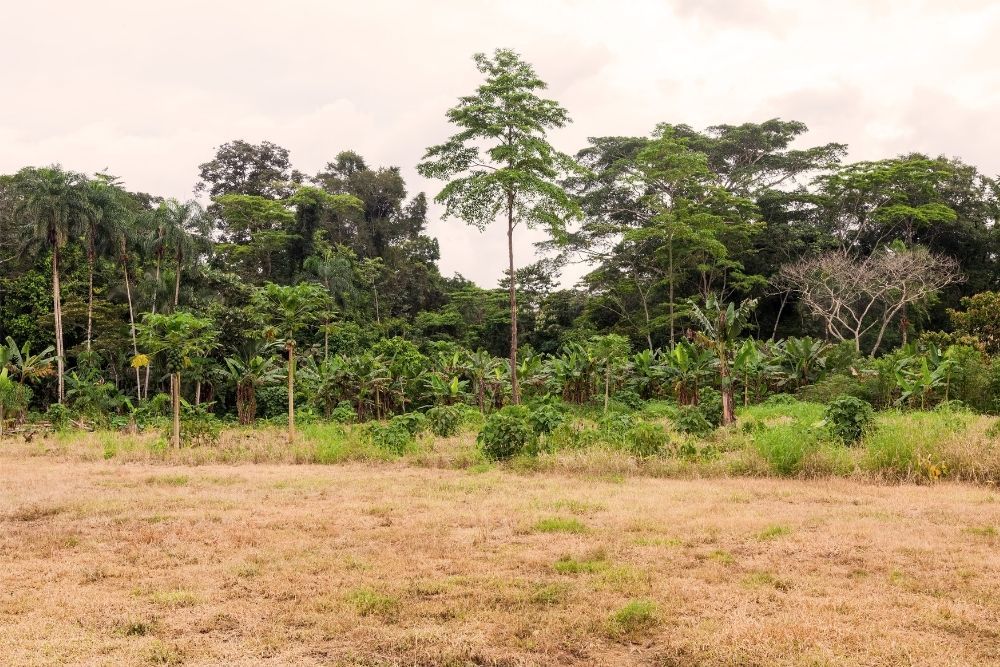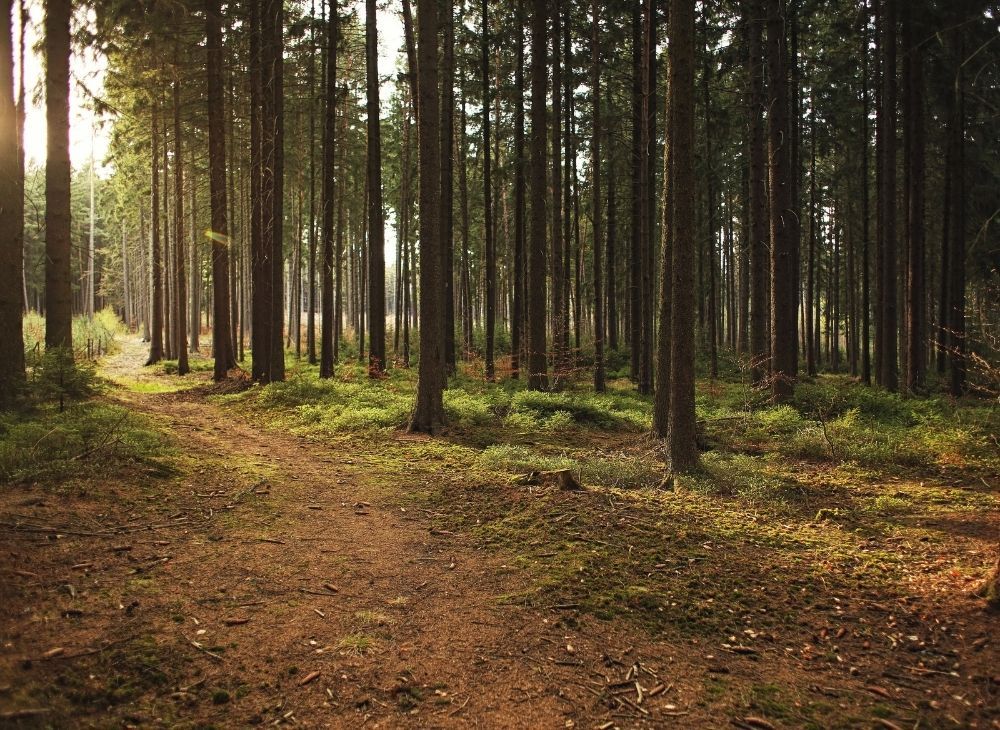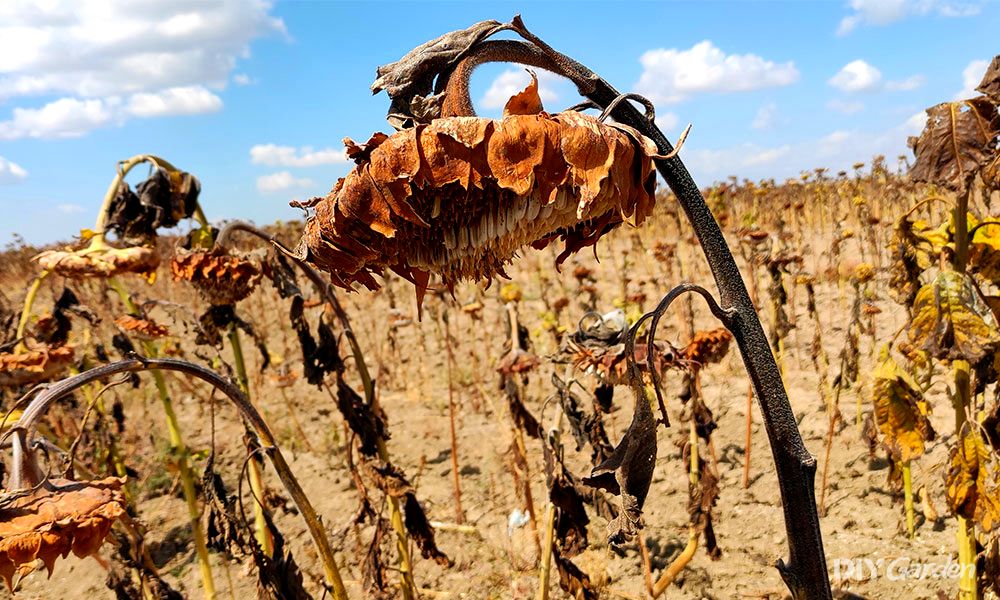
Global climate change is expected to have huge effects on countless aspects of life on Earth over the next few decades.
Scientists have enumerated a daunting list of predicted consequences: extreme weather, desertification, heatwaves and wildfire, endangerment and extinction of numerous species, and more.
Given how all-encompassing the issue is, it’s hard to imagine how deeply the Earth’s changing climate will touch on virtually every aspect of life.
In this article, I want to explain some of the consequences of climate change in great depth.
We may be familiar with the general idea of what a warming planet looks like, but not have a clear idea of just how and why hotter temperatures will affect everything so drastically.
I’ll narrow down the focus and look specifically at how global warming and increased carbon dioxide levels affect plants.
I’ll first briefly outline:
- The basics of climate change and global warming
- Why plants are so important
And then get to the primary purpose of this article, explaining how plants will be affected by global climate change, and how they affect climate processes in turn. Some of the most notable interactions between plants and climate change include:
- A proliferation of plant growth (“greening”)
- Regional water shortages and droughts
- Wildfires
- Changes to plant structures (e.g., thicker leaves)
- Changes to plant communities (as heat-tolerant plants move into warming areas and vulnerable plants move out)
- Threats to crop species
Finally, I’ll recommend some of my favourite resources (such as the Global Forest Watch map) if you want to learn more about plants and climate change.
Climate Change or Global Warming?
These terms often appear interchangeably but they are somewhat distinct. Global warming specifically denotes the rise in Earth’s temperatures due to greenhouse gas emissions. These emissions come from human activities such as the burning of fossil fuels, agriculture, deforestation, and manufacturing.
Climate change is a broader umbrella term, encompassing global warming as well as the broader consequences and altered weather patterns that occur due to hotter temperatures and increased levels of greenhouse gases.
Rising Temperatures: How Much? How Fast?
Average global temperatures have already risen significantly over the past century. You can access data on historical global surface temperatures online, and it’s clear that average temperatures are rising. The global surface temperature today (in 2021) is approximately 1.8o Fahrenheit (or about 1o Celsius) hotter than it was in the 1880s.
How much will global temperatures continue to rise in the next several decades? That depends. But one thing seems certain: In the near future, temperatures will keep climbing.
According to a 2021 report from the Intergovernmental Panel on Climate Change (IPCC), a body comprising over 1300 scientists, “Global surface temperature will continue to increase until at least the mid-century under all emissions scenarios considered.”
Moreover, the IPCC report warns that “global warming of 1.5°C and 2°C will be exceeded during the 21st century unless deep reductions in carbon dioxide (CO2) and other greenhouse gas emissions occur in the coming decades.”
Many scientists expect that by around 2050, the earth could be as much as 3.6oF (or 2oC) warmer than it was before intensive industrialization.
Without substantial cuts to greenhouse gas emissions, we can expect a rise of up to 10oF (or 5.6oC) by 2100. In addition to these hotter temperatures, the Earth will see a drastic increase in atmospheric carbon dioxide.
Those dire predictions luckily are not inevitable: Researchers have been working tirelessly to devise solutions and technologies for cleaner, more sustainable energy—and crucially, the price of many of these technologies is fast decreasing.
When adopting green measures makes sense financially, businesses are more likely to do so voluntarily for their own benefit. This is important for implementing necessary action on a bigger scale.
If governments and corporations take serious action to curtail emissions and to develop and implement greener technologies, a smaller temperature increase is possible. According to the IPCC forecasts, the global temperature rise over the next century could range from 2.5oF to 10oF.
That range contains a huge variety of possible scenarios, and it’s up to us what happens next.
The Importance of Plants
Now that we have some idea of climate predictions for this century, I want to spend some time on the critical functions plants perform within their ecosystems.
Plants provide habitats for innumerable species. The English oak, for example, is a crucial member of its ecosystem, offering shelter and sustenance to hundreds of insect species, in addition to birds, fungi, lichens, bats, badgers, and deer.
Plants reduce air pollution. Green spaces are known to improve air quality. Cities and industrial areas often contain chemical pollutants that can damage our health, but plants help reduce this harm and keep us healthier.
Plants take in carbon dioxide, one of the major greenhouse gases driving global warming. Plants use carbon dioxide to build new tissue and release oxygen into the air. When a forest is burned or cut down, the carbon that had been stored in the trees is sent back into the atmosphere—making it critically important to preserve these habitats.
Plants serve as regulators for the water-cycle, the movement of water from land to atmosphere and back. For instance, plants take up groundwater, which then evaporates into the air. Dartmouth scientist Justin Mankin explains that plants are “like the atmosphere’s straw,” playing a crucial role in how water moves across the Earth’s climate system.
Plants provide us with food, materials, and medicine. Everything we eat either is a plant, or ultimately relies on plants. Not to mention all our wood furniture and hardwood floors, decorative knickknacks, remedies and beauty products sourced from (or developed with the help of) plants, paper books…the list is endless. Sustainable use of these resources is essential if we hope to enjoy them in the future.
Plant Life on a Warming Planet
Plants play an obvious and important role in all of our lives. As global climate change leads to so many wide-ranging effects, it’s natural to wonder how plants factor into all this.
So what do hotter temperatures and increased levels of carbon dioxide have in store for plant life? How have plants begun to change in response to global warming, and how will plants change over the course of this century? And what will the effects be on human communities?
“Greening”: A Proliferation of Plants
For one thing, we’re likely to see a continued proliferation of plant life. A 2020 review article by Shilong Piao, Xuhui Wang, et al. describes this phenomenon of vegetation growth, also known as “greening”: “Vegetation greenness has been increasing globally since at least 1981, when satellite technology enabled large-scale vegetation monitoring.”
Some of this greening is a result of deliberate human action (tree planting on a large scale), and some is inadvertent (vegetation regrowth in abandoned areas). Rising carbon dioxide emissions also promote plant growth, acting as a sort of fertilizer that increases photosynthesis.
This greening might sound great on the surface—Most of us are familiar with tree-planting initiatives intended to absorb carbon and halt global warming. And as two of the study’s co-authors, Chi Chen and Ranga Myneni, explain, this “boom of global greening since the early 1980s may have slowed the rate of global warming…possibly by as much as 0.2 to 0.25 degrees Celsius.”
The more plants the better right? Well…it’s complicated.
The researchers found that greening may “mitigate global warming through enhanced land carbon uptake and evaporative cooling, but might also lead to decreased albedo that could potentially cause local warming.”
The study also notes that “greening enhances transpiration, a process that reduces soil moisture and runoff locally, but can either amplify or reduce runoff and soil moisture regionally through altering the pattern of precipitation.”
In other words, greening affects how much surface water is available and changes rainfall patterns. Some places may become wetter, but others will become drier as a result of these processes.
In the next section, I’ll dig a little deeper into the issue of water availability.
Regional Water Shortages Driven by Changes in Vegetation
A 2019 paper by Justin Mankin, Richard Seager, et al. investigated the relationship between plants, global warming, and water availability.
The paper examines “how plants will acclimate to greenhouse gases, which cause both longer and warmer growing seasons and amplified photosynthesis…leading to changes in ecosystem water consumption and, by extension, the water available in soils and streams.”
The researchers found that an increase in plant life will likely reduce the amount of water available to humans, at least in some regions.
This outcome seems a bit counter-intuitive, especially since plants require less water to perform photosynthesis when there is more carbon dioxide available. So, wouldn’t this mean that in a hotter, more carbon dioxide-rich environment, plants would leave more water behind for humans and animals?
Unfortunately not. That’s because a hotter planet will also have hotter, longer growing seasons, so plants will spend more time growing and taking in water. Plus, the higher carbon dioxide levels cause plants to grow bigger and produce more leaves. When it rains, then, these large and plentiful leaves will facilitate evaporation.
Ultimately, then, the study finds that there will be less available water in rivers and streams in mid-latitude regions, including parts of Central Asia, North America, and Europe. Other parts of the world, however, including tropical and northern regions, should receive enough rainfall to compensate for the proliferating vegetation.
Stephen Leahy summarizes the importance of these findings in an article for the National Geographic. For one thing, people living in affected regions should prepare for longer and more severe droughts.
Climate researchers have warned of the possibility of a “megadrought” afflicting the United States Southwest or Great Plains later this century. Without environmental interventions, scientists estimate the likelihood of such a megadrought at around 80%. And these predictions don’t yet take into account new findings (such as the study by Mankin et al.) on how climate change will affect plants.
In sum, as the Earth grows warmer, and plants take in more water, it is likely that mid-latitude regions will suffer from drought to an even greater extent than previously expected.
The Effects of Drought on Plants
More frequent drought is a well-known consequence of climate change, along with higher temperatures and greater vulnerability to fire. This hotter and drier world will make it harder for plants to take in carbon from the air.
A 2019 paper by Julia Green et al. found that dry years had unsurprisingly negative effects on plants: more plants died, and those that survived struggled to absorb carbon dioxide as effectively. Although during wet years, plants took in carbon dioxide, they did not do so in large enough amounts to compensate for the drier years.
As Blanca Begert sums up in the Yale Environment Review, “the changes in soil moisture lead to a net reduction in the ability of plants to take in the excess carbon in the atmosphere.” In other words, plants that endure droughts become less effective carbon sinks.
And in turn, more carbon is left in the air year after year, creating a feedback loop. More carbon means warmer temperatures and drier soil, which in turn reduces plants’ ability to absorb carbon, which leads back to warming and dryness.
In practical terms, studies such as this one cast doubt on the long-term efficacy of tree-planting initiatives alone and challenge optimistic attitudes toward the “greening” of the past few decades. While plants are essential to our life on Earth and indeed absorb and store carbon from the atmosphere, climate change is hindering their ability to perform their usual activities.
Forests are like two-way streets when it comes to carbon; they can act as both carbon sinks (sequestering carbon dioxide from the atmosphere) and carbon sources (emitting carbon dioxide when the forest is cleared).
Over the past two decades, forests around the world absorbed about twice as much carbon dioxide as they released. During this time, they have collectively served as an essential carbon sink. But the warming climate places this under threat.
Wildfires
Heatwaves and droughts add up to ideal conditions for wildfires. It’s no surprise that bone-dry plants burn much more easily.
In 2021, numerous raging wildfires have hit headlines worldwide. In Siberia, Italy, and the western United States and Canada, unprecedented fires ravaged thousands of acres, swallowed towns, and claimed multiple lives.
2021 isn’t just an anomaly; it’s part of a larger pattern: hotter and longer summers, which lead to drier vegetation, more frequent lightning strikes, and longer fire seasons. One study estimated that the area of land burned in 2015 fires was almost double the area burned in 1984. Researchers have also identified significantly longer fire seasons around the world.
The aerosol particles in fire smoke block sunlight and thus have a minor (and temporary) cooling effect. But overall, wildfires contribute to heating up the climate still further. As trees and vegetation burn, the carbon stored in them is released back into the air. At northern latitudes, fires also burn peat (the carbon-rich forest floor), and so even more carbon is released into the air.
Physical Changes and Adaptations: Thicker Leaves
Not all effects on plants are as dramatic as the devastation of wildfire. Nonetheless, these more subtle impacts can also be significant.
One such example: Many plant species tend to grow thicker leaves in response to higher levels of carbon dioxide. This phenomenon has been observed among multiple kinds of plants, from woody trees to crops such as rice and potatoes.
Researchers Marlies Kovenock and Abigail Swann point out that leaf thickening tends not to be accounted for in environmental models or predictions. They argue that it’s important to quantify plant changes (such as thicker leaves) and to discover their implications for climate change.
Leaf thickening alters the ratio between surface area and mass and affects how the plant carries out sugar storage, evaporative cooling, and photosynthesis, among other activities.
Unfortunately, it seems that thicker leaves are not as good at sequestering atmospheric carbon dioxide, weakening plants’ ability to serve as a carbon sink.
As in the case of water consumption, researchers hoping to create accurate forecasts for the future need to take into account changes in vegetation, which can disrupt the functions and activities that plants have long carried out within their ecosystems.
The Changing Face of Local Plant Communities
Some plant species are strongly associated with particular geographic regions. Sequoias and Joshua Trees in California, live oaks and magnolias in the U.S. South, baobabs in Madagascar, the cedars of Lebanon, sugar maple trees in Canada. But global warming is changing all that.
Biologist Ken Feeley and several co-authors recently undertook a study of almost 20,000 plant species in North, Central, and South America to determine how and where plant species have been altering their ranges, declining in their traditional regions and moving elsewhere.
The researchers report that these changes in plant ecosystems have been occurring since the 1970s. As temperatures rise, plants that can’t handle the heat either move to higher latitudes or elevations, or die out locally. Other plants better able to tolerate heat move in to replace them.
Feeley suggests that there is often an inverse correlation between a plant species’ heat-resistance and its drought-resistance. That is, a heat-tolerant plant is often less drought-resistant. As noted above, climate change increases the likelihood and severity of drought in many regions. This may pose a danger as heat-tolerant but drought-vulnerable species move into warming areas. When drought afflicts the area, many of the heat-loving newcomers will be ill-suited to survive.
In addition, Feeley stresses the ripple effect of plant ecosystems, which are essential for sustaining animal and human life. As some plants leave an area and others move in, animals may likewise be forced to adapt, move, or go extinct.
While Feeley’s survey focused on the Americas, this trend is happening worldwide—and it’s happened before, over 50 million years ago. As the Earth suddenly warmed in an event called the Palaeocene-Eocene Thermal Maximum (PETM), forests of alders, dogwoods, cypress, and sycamores disappeared, and entirely new forests—comprising heat-resistant species—took their place.
Rising temperatures affect each individual plant species differently. While some plants can adapt to certain climate-related changes—and may even flourish—others migrate, and others dwindle or eventually die out.
Writing for Yale Environment 360, Zach St. George explains that the changes we’re seeing in the 21st century may well dwarf those of the distant past: “The climate is currently warming at least 10 times faster than it did at the onset of the PETM.”
Many scientists therefore expect to see some dramatically changed plant communities in the coming years—hard as it is to imagine Madagascar without its baobabs or Lebanon without its cedars. And these transformed plant communities will likely be accompanied by changes in wildlife, as insects, birds, and mammals that can’t adapt to the new ecosystem migrate elsewhere.
Threats to Crop Species
In addition to sweeping transformations across global ecosystems, climate change poses specific threats to many of the crops that we rely on. The effects of weeds, insects, and crop diseases are expected to intensify in the next decades. Furthermore, elevated carbon dioxide levels may reduce how nutritious crops are.
In some cases, crop species are more vulnerable to climate change than weed species. While the crop plants struggle under heat stress, heat-tolerant weeds prosper. In addition, warm temperatures may expand the range of weeds, allowing them to affect crops in new regions.
Warm temperatures also have an effect on insect pests, speeding up their life-cycles, leading to larger pest populations produced in a single growing season, and allowing them to expand their range.
Crops themselves can be weakened by stress from rising temperatures or changes in soil moisture, which in turns makes them vulnerable to disease.
Then there’s the issue of carbon dioxide concentration. As I’ve explained above, high levels of carbon dioxide promote photosynthesis and lead to greater plant growth. But crops that are grown under such high-carbon dioxide conditions are less nutritious, containing lower amounts of vital nutrients such as iron and zinc, while grains also have less protein.
Overall Effects of Climate Change on Plants
Given the many diverse plant species out there, there is no one-size-fits-all prediction covering how each species will fare. Heat-loving plants, for instance, may thrive and expand their ranges—so long as they can withstand the other conditions associated with climate change, such as increased drought and wildfires.
Due to the fertilizing effect carbon dioxide has, plant life in general has been proliferating. So, in a small sense, climate change has some benefit for plants—but that’s not the whole story. As corporate research fellow Richard Norby explains in the Scientific American, “You can have positive and negative things going on at once, and it’s the net balance that matters.”
For one thing, this fertilization effect has its limits. Plants need nitrogen in addition to carbon dioxide, so limits on available nitrogen will restrict plant growth, regardless of how much carbon dioxide there is.
And for another, high levels of greenhouse gases produce additional effects beyond simply stimulating photosynthesis; they also contribute to climate change, leading to conditions that are ultimately harmful for many plants.
Overall, the harmful effects of climate change outweigh the positive. As Earth’s temperatures rise, plants suffer from insufficient soil moisture and heat stress, which interfere with the plant’s ability to survive and reproduce. In more severe cases, vegetation is subject to drought or wildfire.
These harmful effects for plants in turn have consequences for humans, such as regional water shortages and decreased nutritional value of crops.
Useful Resources for Learning More About Plants and Climate Change
Global Forest Watch
This map-based site is excellent and allows you to gain insight into several different issues:
- Check out recent deforestation and fire alerts.
- Visualize patterns in tree cover from 2000 to present.
- Read reports on tropical forest loss.
It’s a real wealth of information, and they also run a blog, which translates some of this data into short, informative articles.
Woodland Trust
This organization aims to protect woodlands and wildlife communities across the United Kingdom. They plant trees, manage and restore over 1000 forests, and work to conserve threatened wildlife species such as ospreys. Their website is a wonderful resource for learning more about British trees, woodland plants, and wildlife. They maintain an informative blog (especially recommended for families with children who are interested in helping out local wildlife and enjoying the outdoors), and they also offer a Tree ID app!
Yale Environment 360
This online magazine published at the Yale School of the Environment is a great way to keep up-to-date with environmental news. It offers a combination of reporting, analysis, and opinion articles, written by scientists, journalists, and policy makers.
NASA: Global Climate Change
I mostly associate NASA with astronauts and outer space, but they also maintain materials on global warming right here on Planet Earth. You can access facts and FAQs, news articles, interactive features, and programming for kids and educators.
One of my favourite features is the Climate Time Machine, which allows you to trace how sea ice, sea levels, carbon dioxide concentration, and global temperature change over time. On the global temperature map, for instance, you can drag a slider from 1884 right up to 2020.
The sea level map lets you visualize the effects of up to 6 metres rise, which would happen if the Greenland ice sheet melts away completely (as of now, it’s only thinning in parts).
And what about carbon dioxide concentration, a factor that we know to influence vegetation? The map helps you visualize how levels of the gas have changed from 2002 to 2016.
Kurzgesagt – In a Nutshell
This animated video channel creates colourfully illustrated explainer videos on interesting topics, including climate change. Each video centres around a particular theme, challenge, or question: What can I as an individual do (if anything) to combat climate change? What can we expect in the near future? How effective might solutions like nuclear energy or geoengineering be? If you’re looking for short yet thought-provoking videos that engage your curiosity, give Kurzgesagt a try!
Plant, Cell & Environment: Climate Change
This special journal issue is available online, gathering scholarly articles on the effects of climate change on plants. As the issue abstract explains, “Climate change has many consequences for plants, be it heat waves, increased flooding, or droughts. Besides these knock-on effects of global warming, rising carbon dioxide concentrations and temperatures directly affect plant growth, reproduction, and resilience.” These impacts are diverse, hard to predict, and vary across regions and species—but they “could have devastating consequences for humankind.” If you want to take a really deep dive into this topic, this journal issue is a good place to start.
Conclusion
Scientists are still figuring out the precise effects that climate change will have—and is already having—on all sorts of plant life. Some species will get lucky and survive, even thrive. Those that can handle hotter temperatures have a bright future ahead (unfortunately for humans, some of those plants seem to be weeds, which increasingly threaten to choke out crops).
Other plant species will have to adapt, migrate, or face extinction. Already, we’ve seen a glimpse of this future, as 2000-year-old baobabs die and severe wildfires decimate acres of forest.
One thing is certain: Rising global temperatures, along with higher levels of carbon dioxide, continue to have a significant influence on plants, which in turn has an impact on all of us.

